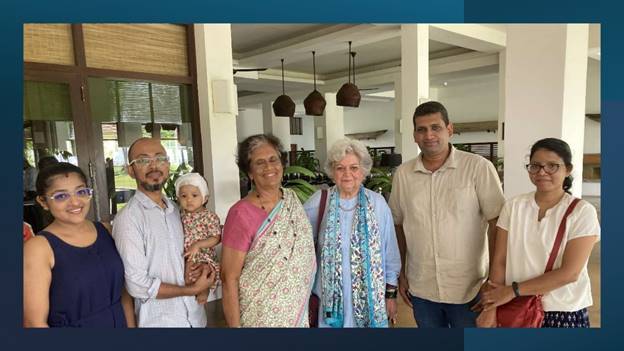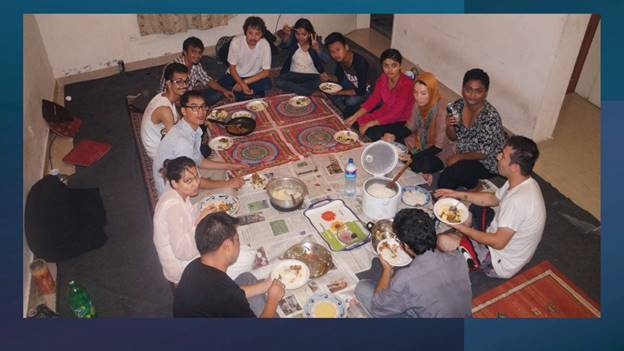Lahore Fort (right to left): Subista Kayastha and Kunjan Tamang from Nepal, Mir Musavir from Kashmir, Yeshifrom and Dorji from Bhutan, driver Siddiq Sahib, Dhanuska from Sri Lanka - Photo via Salima Hashmi.
On ‘Southasian’ Artistic Consciousness, Solidarity and a Network of Peacemongers
Having escaped communal violence in Lahore, 1947, thanks to a kindly ‘tongawalla’, a young man who went on to become a UNESCO Goodwill Ambassador set up a foundation with the dream of creating networks of peacemakers. His legacy continues
By Salima Hashmi
Lahore, Pakistan
It is 1947. A young student from the renowned Government College, Lahore, is on the run, trying to escape communal riots. He is easily identifiable as a Sikh; his turban marks him from afar. He is waiting for the sun to set, allowing him to make his way towards the refugee camp, not far from the border.
Suddenly, a tonga stops by him. The kindly tongawallah, noticing the panic, offers him a lift to the camp at Walton. Grateful, the young man jumps into the carriage and covers himself, until he reaches safety.
The young man’s name was Madanjeet Singh. Decades later, the incident above served as the backstory behind the institution he set up in the year 2000 while serving as a UNESCO Goodwill Ambassador.
The institution is the South Asia Foundation , which aims to bring young people from all eight Southasian countries together to study in diverse fields – journalism, art and design, water management, forestry, development studies, and green energy technology – in institutions across the region. The dream was to create networks of peacemakers.
Since the Beaconhouse National University, Lahore, opened its doors in September 2003, its School of Visual Arts and Design has been among the beneficiaries of the Foundation.
The University, and the student body included 14 students, two from each of the SAARC countries, from Afghanistan to the Maldives, all of whom studied together for four years. This set the tone for what became a unique art and design student community in Southasia.
As Dean of the School of Visual Arts and Design, this was an exciting and absorbing opportunity for me to experiment and help create fresh pedagogical paradigms with a highly motivated and adept faculty.
Madanjeet Singh’s legacy
Two decades after Madanjeet Singh passed away in 2013, his legacy continues. In the twenty years since the program started, young artists from across Southasia attending undergraduate and MA programs have grown in number.
Apart from their own countries, they have now spread across the globe. The program in visual arts and design has been a radical one, incorporating new technologies alongside research into historical sources of artmaking in Southasia.
In Pakistan, the School of Visual Arts and Design recognized the need to locate its curriculum firmly in the 21st century, without sacrificing the richness of the cultural tapestry of the region. The unusual infusion of students from Afghanistan, Nepal, Bhutan, India, Sri Lanka, Bangladesh, and Maldives reinforced the tradition of Lahore being a melting pot.
Many histories, peoples, civilizations, faiths, and cultures have contributed to the local saying '‘You haven’t lived if you haven’t seen Lahore’. The coming together of these aspiring artists and designers, with their own sub-continental beliefs and practices, made it a stimulating mix for the faculty, drawn from an equally eclectic pool of art educators and practitioners.
Prominent artists like Malcolm Hutchison, Sophie Ernst, Huma Mulji, Julia Ahmed, David Alesworth, Risham Syed, Malcolm Hutchison, Gwen Kulick, Kiran Khan, and others came together to teach in the first decade. It

Alumni lunch in Sri Lanka, 2023. From left to right: Shironi Joseph from Jaffna, Pradeep Thalawatta from Rathnapura, Ehyni Thalawatta, former President Chandrika Bandaranaike Kumaratunga, Prof. Salima Hashmi, Janaka Senivirathna from Mathara, Krishnapriya from Jaffna. Photo by Salima Hashmi
was a heady mix with many visiting artists and scholars including Naazish Ata Ullah, Quddus Mirza, Imran Qureshi, and Farida Batool.
There were visitors from across the region like Bharti Kher, Shabnam Virmani, Amar Kunwar, Saiful Haq Omi – the list stretches on and on, over the past two decades. There has been a constant re-assessment and recalibration of the curriculum. New programs and courses are added every year.
The conversations and hands-on engagements in the studios and lecture rooms become veritable seminars on practices, theory, and historical overlapping. Not entirely unexpectedly, the alumni became infused with the pedagogical energy being generated. As they proceeded into the ‘real’ world after their time in Lahore, their artistic practices had to contend with the fresh context of ‘home’ to be experienced anew and thought about.
Young Southasian artists
The last decade and a half have witnessed a blossoming of younger voices across Southasia, who have fearlessly begun to blur the boundaries between the silos which once labeled artistic practices. While rooting their work in the socio-political realities of the region, these artists are interrogating complex artistic vocabularies.
Ayesha Sultana was the first of our graduates to initiate investigations into space, across a range of materials and mediums, winning the emerging artist award at the Dhaka Art Summit in 2014. Other young artists were working in video, digital formats, performance, fiber arts, and

Alumni lunch in Sri Lanka, 2023. From left to right: Shironi Joseph from Jaffna, Pradeep Thalawatta from Rathnapura, Ehyni Thalawatta, former President Chandrika Bandaranaike Kumaratunga, Prof. Salima Hashmi, Janaka Senivirathna from Mathara, Krishnapriya from Jaffna - Photo by Salima Hashmi
jewelry, along with painting and three-dimensional works. The alumni networks expanded as they found common ground with one another.
Multiple others started finding residencies and spots in biennales and triennales, not only in Southasia but across the globe. They include Basir Mahmood, Unum Babar and Ghulam Muhammad from Pakistan, Kubra Khademi and Aziz Hazara from Afghanistan, Moonis Shah from Jammu & Kashmir, Hema Sheroni, Danushka Marasinghe and Pradeep Thalawatta from Sri Lanka, Vidhya Saumaya from India, Koshal Hamal and Sajana Joshi from Nepal, and Mainul Islam Tharmalingam from Bangladesh.
Ghulam Muhammad won the Jameel Art Prize, among others. Kubra Khademi from Afghanistan was passionate about performance which was her metier; her final thesis performance is still remembered for its chilling implications.
She struggled with a hostile working environment on her return to Kabul. Her street performance Armor in 2015 created a furore that was life-threatening, and she had to go into hiding. It was UNESCO that came to her rescue and arranged for her to be granted asylum in France. She was recently created a Knight of the Order of Arts and Letters by the Ministry of Culture in France.
The first nominees from troubled Jaffna, in Sri Lanka were welcomed in 2017. Their life stories were harrowing beyond description, like those of others from Jaffna who had come to become part of the BNU family. The number of alumni from Jaffna has grown, as has their subsequent presence in the Sri Lankan and Asian art world. To quote Jagath Weerasinghe, the veteran Sri Lankan artist: “The experience of being together in Lahore has transformed contemporary art in Sri Lanka.”
The sense of being ‘Southasian’ has seeped into the consciousness of artists and designers trained in Lahore. They find common linkages long after they have left when they find themselves co-exhibiting in art fairs, galleries, and museums. There is a flash of recognition and ownership of a regional identity reinforced through work and recall.
The most vivid instance was the evacuation of artists from Afghanistan after the Taliban takeover in 2022. Kubra Khademi, then living in Paris, was able to garner support from artist groups in Europe to ensure safe flights for other Afghan artists to France, Switzerland, and Germany.
Another Afghan artist Sher Ali graduated with a distinction from SVAD. Several years later, his wife Tamanna was at SVAD while he looked after their child in Kabul when the Taliban took over. They have been able to relocate to Melbourne where Sher Ali is already gaining art commissions and exhibition opportunities. The support and solace offered by the Southasian artist community have been heartwarming.
These alliances and shared concerns reinforce regional South Asian identities and are the harbingers of artistic voices that speak in unison.
(Salima Hashmi is an artist and art educator based in Lahore. She is a founder member of the Southasia Peace Action Network – Sapan - and a board member of the South Asian Foundation. This article is adapted from her piece originally published in Take on Art Magazine’s TAKE South Asia issue, February 2024, with the title ‘Pedagogical Networks in South Asia’, and is reproduced here with her permission.)
Hyperlinks used in article:
1. South Asia Foundation: https://www.southasiafoundation.org/
2. Kubra Khademi: https://www.youtube.com/@kubrakhademi7610
3. Street performance Armour: https://www.youtube.com/watch?v=nXuNtZPMDvQ
* Note on Southasia as one word: We use ‘Southasia’ as one word, “seeking to restore some of the historical unity of our common living space, without wishing any violence on the existing nation states” - Himal Southasian
Sapan News
Back to Pakistanlink Homepage

